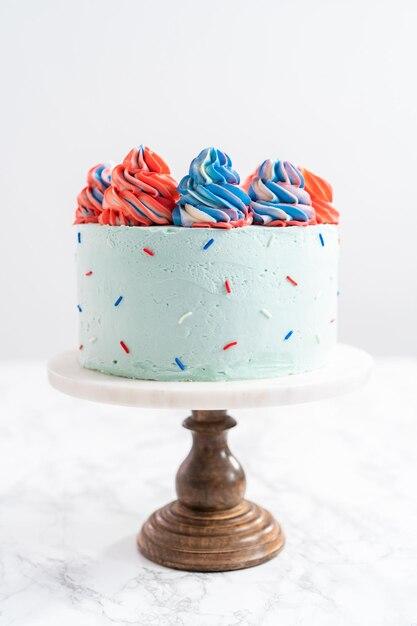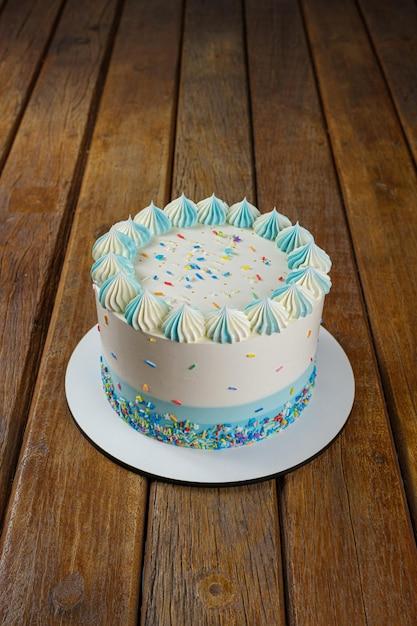Are you tired of your buttercream frosting turning out too runny or overly sweet? Well, fret no more! In this blog post, we will dive into the wonderful world of buttercream and learn how to take it to the next level by adding the magical ingredient – cornstarch.
We will answer all the burning questions you may have about this process, such as how cornstarch helps thicken and stabilize your buttercream, how to adjust the sweetness level, and even how to rescue a runny batch. By the end of this post, you’ll be armed with all the knowledge you need to create picture-perfect buttercream frosting that your taste buds and guests will adore.
So, let’s get right into it and make 2023 the year you master the art of adding cornstarch to your buttercream icing!
How to Incorporate Cornstarch into your Buttercream
If you’re a budding baker or someone with a love for all things sweet, then you’ve probably dabbled in making your own buttercream frosting. It’s the perfect way to add that extra layer of deliciousness to your cakes, cupcakes, or even just to sneak a spoonful when nobody’s looking (I won’t tell if you won’t!). But have you ever tried adding cornstarch to your buttercream? If not, you’re in for a treat. In this guide, we’ll walk you through the steps on how to incorporate cornstarch into your buttercream and why it’s a game-changer.
Why Cornstarch
Before we dive into the “how,” let’s take a moment to appreciate the wonders of cornstarch. This pantry staple isn’t just for thickening sauces and gravies, oh no! It’s a magical ingredient that can transform your buttercream in ways you never imagined. Adding cornstarch to your buttercream creates a velvety texture that’s lighter than air and will make your taste buds do a happy dance. Trust me, once you try it, there’s no going back!
Step 1: Gather Your Ingredients
To get started, you’ll need the following ingredients:
- 1 cup of unsalted butter (room temperature)
- 4 cups of powdered sugar
- 2 tablespoons of cornstarch
- 2 teaspoons of vanilla extract
- A pinch of salt
Step 2: Cream the Butter
In a mixing bowl, cream the butter until smooth and fluffy. This will take around 2-3 minutes on medium speed. Remember, the key to a fluffy buttercream is to give your butter some love and attention. After all, it deserves it!
Step 3: Sift in the Sugar
Slowly sift in the powdered sugar to the butter. Sifting helps to prevent any lumps in your buttercream and ensures a smooth consistency. Plus, it adds a touch of elegance to your baking routine. So grab that trusty sifter and let the sugar rain down!
Step 4: Add in the Cornstarch
Ah, the star of the show – cornstarch! Sprinkle in the cornstarch while continuing to mix on low speed. This magical powder will work its wonders by giving your buttercream that dreamy velvety texture we all crave. Just wait until you take your first bite – it’ll be love at first taste!
Step 5: Pour in the Vanilla Extract
Now it’s time to add a splash of vanilla extract for that irresistible aroma and flavor. Vanilla is like the Beyoncé of baking – it brings that extra something-something that’ll make people bow down to your buttercream skills. Okay, maybe not literally, but close enough!
Step 6: Give it a Pinch of Salt
To balance out the sweetness and enhance the flavors, add a pinch of salt. It may seem counterintuitive, but trust me, it works like magic. The salt will bring out the best in all the other ingredients, creating a harmonious symphony of flavors that’ll make your taste buds sing!
Step 7: Whip it, Whip it Real Good!
Time to crank up the speed and whip that buttercream into perfection. Mix on medium-high until light and fluffy, approximately 3-5 minutes. This will incorporate air into the mixture, resulting in a cloud-like frosting that will make you wish you had a bigger cake to slather it on.
And there you have it – your very own cornstarch-infused buttercream! It’s smooth, it’s creamy, and it’s guaranteed to take your baked goods to the next level. So go ahead, grab that piping bag, and let your imagination run wild. After all, life is too short for boring buttercream!
Now that you know the secret to incorporating cornstarch into your buttercream, get ready to impress your friends and family with your newfound baking prowess. Remember, the key to a successful buttercream lies in the details and the love you put into it. So go forth and whip up some frosting magic – your taste buds will thank you!
FAQ: How Do You Add Cornstarch to Buttercream
Will the buttercream icing harden in the fridge
No, buttercream icing does not harden in the fridge. In fact, refrigerating buttercream can actually cause it to become firm, making it difficult to spread. To maintain a smooth and spreadable consistency, it is best to keep buttercream at room temperature.
Can you use cornflour to thicken buttercream
Yes, you can use cornflour to thicken buttercream. Cornflour acts as a natural thickening agent, giving your buttercream a slightly denser texture. However, it’s important to use cornstarch instead of cornmeal or corn masa to ensure the desired results.
Can I add vinegar to buttercream
Adding vinegar to buttercream is generally not recommended. While vinegar can be used in some recipes to add tanginess or balance flavors, it can significantly alter the taste and texture of buttercream. It’s better to stick to traditional ingredients when making buttercream.
What does adding cornstarch to buttercream frosting do
Adding cornstarch to buttercream frosting helps to stabilize it and give it a thicker consistency. Cornstarch absorbs moisture and helps prevent the buttercream from becoming too soft or runny, making it easier to work with and decorate cakes.
How long does buttercream need to set
Buttercream typically needs about 1 to 2 hours to set at room temperature. During this time, the buttercream will firm up slightly, allowing it to hold its shape better when piped or spread onto cakes. If you’re in a hurry, you can also chill it in the refrigerator for about 15-30 minutes to speed up the setting process.
How do you thicken up frosting
To thicken up frosting, you can add small amounts of powdered sugar or cornstarch. Start with a teaspoon at a time and mix it in thoroughly until you achieve the desired consistency. Be cautious not to add too much at once, as it may make the frosting overly sweet or grainy.
How do you unsweeten store-bought icing
If you find store-bought icing too sweet, you can try adding a tablespoon of unsweetened cocoa powder or a pinch of salt to balance the sweetness. You can also add a little lemon juice or zest to add a tangy flavor that helps to cut through the sweetness.
How do you make frosting less sweet
To make frosting less sweet, you can add a neutral ingredient such as unsweetened whipped cream or cream cheese to the recipe. These ingredients help to mellow out the sweetness and add a subtle tang. You can also add a pinch of salt or a squeeze of lemon juice to reduce the overall sweetness.
How do you thicken buttercream icing with cornstarch
To thicken buttercream icing with cornstarch, start by dissolving 1 teaspoon of cornstarch in 1 tablespoon of water. Heat this mixture in the microwave or on the stove until it thickens and becomes translucent. Allow it to cool completely before gradually adding it to your buttercream while beating on low speed until desired thickness is reached.
How do you stiffen buttercream without icing sugar
If you want to stiffen buttercream without using icing sugar, you can try adding a tablespoon of meringue powder or instant pudding mix. These ingredients help to stabilize and thicken the buttercream without making it excessively sweet.
What do I do if my icing is too sweet
If your icing is too sweet, you can try adding a tablespoon of unsweetened cocoa powder or a pinch of salt. These ingredients help to balance the sweetness and add depth of flavor to your icing. Additionally, you can also add a small amount of lemon juice or zest to give it a tangy twist.
Can I add flour to buttercream
Adding flour to buttercream is not recommended. Flour can create a grainy texture and interfere with the smoothness of the buttercream. It’s best to use cornstarch or powdered sugar to achieve the desired thickness and consistency.
How do you fix runny whipped cream
If your whipped cream is runny, try adding a tablespoon of powdered sugar or cornstarch to help stabilize it. Whip the cream again until it reaches a thicker consistency. Be careful not to overwhip, as it can turn into butter.
What can I add to make my buttercream thicker
To make your buttercream thicker, you can add small amounts of powdered sugar or cornstarch while mixing on low speed. Start with a teaspoon at a time and continue to add until desired thickness is achieved. Remember to mix well between each addition to ensure proper incorporation.
Why is my buttercream grainy and runny
Buttercream can become grainy and runny due to several reasons. It could be that the butter was too soft or melted when mixing, the sugar was not fully dissolved, or the buttercream was overbeaten. To fix grainy and runny buttercream, try refrigerating it for a short period to firm it up, then remix on low speed until smooth.
Can I add flour to icing sugar
Adding flour to icing sugar is not recommended. Flour can create a lumpy and grainy texture in your icing, affecting its overall smoothness and appearance. Stick to using powdered sugar as your primary thickening agent.
How do you stiffen buttercream icing
To stiffen buttercream icing, you can add powdered sugar gradually while mixing on low speed. Keep adding small amounts until the desired stiffness is achieved. Be cautious not to add too much, as it can make the icing overly sweet.
Can you overmix buttercream
Yes, you can overmix buttercream. Overmixing can cause the buttercream to lose its light and fluffy texture, making it heavy and dense. It is best to mix the buttercream until all the ingredients are fully incorporated and stop once it reaches a smooth consistency. Overmixing can also lead to the butter separating from the sugar, resulting in a grainy texture.

